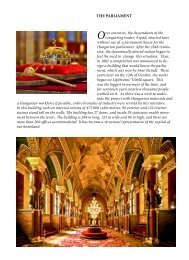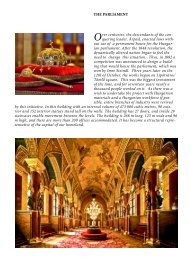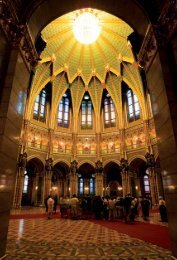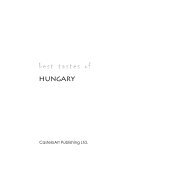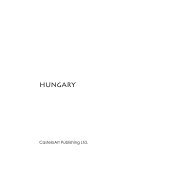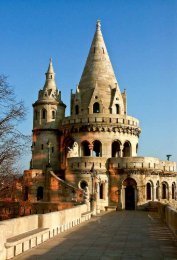BP_traveler_EN....
You also want an ePaper? Increase the reach of your titles
YUMPU automatically turns print PDFs into web optimized ePapers that Google loves.
BUDAPEST<br />
CasteloArt Publishing Ltd.
UNESCO World Heritage<br />
Budapest is one of the most beautifully situated cities in the world. The plains of Pest along with the hills and mountains of Buda , united by the River Danube<br />
produces a unique panorama. In addition to aesthetic assets, Budapest also boasts many historical treasures. One can find remains from the settlement<br />
of the ancient Roman Aquincum, buildings, baths constructed and reconstructed during the Ottoman occupation, churches, museums built during the<br />
reign of the Hapsburgs and numerous other beautiful and interesting sights, which spectacularly demonstrate various historical periods of the capital city.
The UNESCO World Heritage Committee recognised its unique value and in 1987 included Budapest in the World Heritage List. The World Heritage listed<br />
area covers approximately 60 hectares , extending from Margaret Bridge to Szabadság Bridge, including the building complex of the Castle District of<br />
Buda, Gellért Hill with the Statute of Liberty and Citadella, and the Gellért Bath, the Houses of Parliament, the building of the Hungarian Academy of<br />
Sciences, the Gresham Palace, the Vígadó of Pest and the building of the Church of the Parsonage of the Inner City.
The Parliament<br />
Over centuries the descendants of the conquering leader, Árpád, enacted laws without having a permanent house for the Hungarian parliament.<br />
After the 1848 revolution, the dynamically altered nation began to feel the need for the change of the situation. Thus, in 1882 a competition was<br />
announced to design a building that would house the parliament, which was won by Imre Steindl. Three years later on the 12th of October, the<br />
works began on Lipótváros’ Tömlő square.<br />
4
The Parliament<br />
This was the biggest investment of the time, and for seventeen years nearly a thousand people worked on it. Standing in the middle of the great<br />
vaulted hall, one can see the northern and the southern lounges on the right and left. The picture depicts the southern lounge, which used to<br />
belong to the Lower House. Passing through the northern lounge, opposite the chamber/hall of the House (it once was the conference room of the<br />
Lower House) in the northern annex, we reach the conference room of the Upper House. This is often used for housing international conferences.<br />
7
The Chain Bridge<br />
In winter one used to be able to walk on the iced surface of the Danube, but during ice drifts, commuting in this way between the two banks of the<br />
river became impossible. Once, István Széchenyi was forced to wait an entire week in December of 1820 until he found one brave boatman who<br />
would take him to the other side. After this incident, he initiated the building of “thae Bridge” . Building this bridge had historical significance, since it<br />
was the first permanent bridge between Pest and Buda. After being taken over by local traffic in 1849, it became a national symbol of development.<br />
Both Hungarians and visitors enjoyed the use of this bridge.<br />
8
9
10
Freedom Bridge<br />
The bridge was given to the public as a part of the Millennium celebrations, but its original name was Franz Jozef. It was built between 1894 and<br />
1896, and the monarch himself hammered in the last nail. During the Second World War-similar to other bridges of Budapest - it was demolished,<br />
but during the city’s rebuilding, it was the first one to be erected again. It became a national emblem, the symbol of freedom.<br />
11
Elizabeth Bridge<br />
The first steps on today’s Erzsébet híd (Elizabeth Bridge) started echoing more than a hundred years ago. At that time this crossing point above<br />
the Danube was referred to as the bridge of the Eskü tér (Promise Square) and its pavement was made of wooden cubes. Building started in 1897<br />
when there were only two other bridges: the Lánchíd (Chain Bridge) and the Margit híd (Margaret Bridge).<br />
12
Although a price of two krajcár (the currency of the time, the equivalent of a penny) had to be paid in the little buildings at either end of the bridge,<br />
the citizens were glad to use the new bridge. The original bridge was bombed by the German troops in 1945. Then, only years later (November<br />
21, 1964) was the new construction handed over.<br />
13
Buda Castle<br />
The history of Buda Castle goes back to the days of old times. The early central palace was severely damaged in the battles against the Turks, but<br />
later thanks to the initiative of Maria Theresa, it was renovated in a majestic baroque style.<br />
14
Unfortunately, the palace fell victim to the Second World War, and at present it does retain any parts which would reflect the luxury of the bygone<br />
days’ kings.<br />
15
Buda Castle<br />
Today, it has an important role in the country’s cultural life since its chambers are used by the Hungarian National Gallery, the National Széchenyi<br />
Library, the Ludwig Museum of Contemporary Art and the Historical Museum of Budapest.<br />
16
17
18
The Fishermen’s Bastion<br />
Today’s Halászbástya (the bastion of the fishermen) was built in 1902 in the place of a former fortress. It is on the castle’s wall, but contrary to its<br />
name, it never served the purpose of protection. Its seven towers represent the seven leaders of the conquering Hungarians. The lookout from<br />
these towers is a gorgeous sight.<br />
19
New York Palace<br />
The building of the New York Palace was an assignment of the New York Insurance Company. Alajos Hauszman was in charge and it was built based<br />
in the Italian eclectic style. In 1894, a beautiful café house (the palace’s main attraction) was opened and soon became the haunt of the artistic<br />
and literary bohemia. The age’s most respected journals, the Nyugat’s editorial office was found here, as well. At present the building houses the<br />
Luxury Hotel, owned by the Boscolo Group, and its unique pomp is still a reminder of the one-time atmosphere.<br />
20
21
22
The Gresham Palace<br />
This supreme palace was erected by The Gresham Life Assurance Society to be used as their foreign headquarters. The most famous architects<br />
and artists of the age worked on it and completed it by 1906 mainly for the British aristocracy. It has been known worldwide since 2004 as the Four<br />
Seasons Hotel. Gresham Palace is a hotel for those who are fond of splendor and hearty hospitality.<br />
23
Sándor Palace<br />
24<br />
This classicist palace, next to the Buda Castle, was erected in 1806, on behalf of Count Vince Sándor. After 1867, it had been owned by the Pallavicini<br />
family who later sold it to the state. From 1867 on until the Second World War, Gyula Andrássy and the eighteen other prime ministers lived and<br />
worked in this building. During the bombings most of it was demolished, and parts of its equipment that hadn’t been destroyed went to the Soviet<br />
Union as indemnity. After years of researching and designing, the palace got its splendour back by 2002 and since 2003 it has been the office of<br />
the Hungarian prime minister.
25
26
Budai Vigadó<br />
The Budai Vigadó, built between 1898 and 1900 in the eclectic style, satisfied all needs of the citizens of Buda at that time. It was the town centre,<br />
including a library, theatre and was home to other cultural events. There where also a café and restaurant. Upon entry to the building, one will<br />
find an imposing lobby, followed by the sight of the wide columnar marble stairs and the richly decorated spacious theatre entrance hall. Today the<br />
building is the home of the House of Traditions and the Hungarian Cultural Institute.<br />
27
Comedy Theatre<br />
This imposing historical building was erected within one year in 1896. Moorland stretched behind the building acan accommodate more than one<br />
thousand people. The Vígszínház was almost demolished by the World War II bombardment and thus had to be rebuilt. The Magyar Néphadsereg<br />
Színháza (Theatre of the Hungarian People’s Army) as it was known after 1951, was renamed in 1961 when it regained its legendary original name.<br />
The theatre still maintains its double purpose, to serve the audience and to preserve our heritage.<br />
28
29
30
Pesti Vigadó<br />
Pesti Vigadó was inaugurated in 1865 within the frame of a festal ball “with a shining and public dance”. The building was constructed after the plans<br />
of Frigyes Feszl. It became the capital’s most important cultural institute. Several significant persons entered the stage in this building. Among them<br />
were Zoltán Kodály, Béla Bartók and Ernő Dohnányi. The buildings were severely damaged in World War II. In 1980, after its renewal it was again<br />
opened for the public. Currently the Pesti Vigadó serves as a venue for concerts, various conferences, banquets and receptions.<br />
31
Rácz Bath<br />
32<br />
The octagonal cupola of the Rácz Bath of Turkish origin was built in the 16th century, during the Ottoman occupation of Hungary. After Buda had been<br />
retaken, it became the property of the imperial chamber. Later it was owned by the Heinrich family. At that time the bath was renovated and extended<br />
according to Miklós Ybl’s plans. In the Second World War, it was heavily damaged. Later, a significant part of the still remaining building was pulled down<br />
during the construction of the Elizabeth Bridge. The Rác medicinal bath was renewed as part of the complex of the Rácz Hotel & Thermal Spa built by 2010.<br />
This historical bath complex constitutes a modern Thermal and Day Spa. The spa includes 13 pools, 21 treatment rooms, a wide choice of saunas and leisure<br />
areas, a sunbathing terrace in the loft, and a separate VIP section. The first guest are expected to be admitted in Autumn 2011.
33
34
The Vajdahunyad Castle<br />
The end of the 19th century brought a special series of events for Hungarians. The nation was celebrating the foundation of the state. The Millennium<br />
Exhibition of 1896 was part of these celebrations. The event resulted in erecting many new buildings. One of them, found in the Városliget, was this castle<br />
with its four different architectural styles designed and carried out by Ignác Alpár. These buildings all display the stylistic features of other monuments<br />
from Hungary’s past which are located elsewhere in the country. After the conclusion of the celebration, the castle was given to the Museum of Hungarian<br />
Agriculture where visitors are always welcome.<br />
35
Budapest Zoo and Botanical Garden<br />
The history of the zoo goes back long before 1866. Most of its buildings were finished by the opening year of 1866. Although, many things have changed<br />
since then, this zoo is considered as an “art relic”. It was among the first zoos in the word which kept a giraffe and that special animal –due to the mediation<br />
of Sissy- was transferred here from Schönbrunn. Our picture shows the ornamented Elephant House, which has been recently renovated.<br />
36
37
38
Gundel Restaurant<br />
The achievement of the life’s work of founder Károly Gundel is that Gundel is today synonymous with the citadel of Hungarian hospitality and<br />
gastronomy. More than 100 years after its establishment, the restaurant is proud to perpetuate Károly Gundel’s finest traditions of catering.<br />
These include hospitality, the tradition which pervades the building, as well as the fact that meals are prepared from the best ingredients and<br />
elegantly decorated before being served to customers.<br />
39
Széchenyi Bath<br />
This magnificent building, which is Europe’s biggest thermal bath complex, was Pest’s first bath.<br />
40
Thanks to mining engineer Vilmos Zsigmondy’s discovery the bath was in partial operation in 1881.<br />
41
Széchenyi Bath<br />
Later, it was rebuilt according to the plans of Győző Czigler to meet the age’s requirements and it became well-known as the Széchenyi Bath.<br />
Since then it has always been a popular place.<br />
42
43
City Park Ice Rink<br />
The City Park Ice Rink began to welcome lovers of skating in 1870, following the persistent work of the Pest Skating Association. Skating was<br />
accompanied by huge enthusiasm among residents of the capital.<br />
44
In 1874 a skating hall was built to designs by Ödön Lechner, and later in 1895 a building in Neo-Baroque style was erected to designs by Imre<br />
Francsek Snr. Still today, the City Park Ice Rink offers a warm welcome to lovers of skating.<br />
45
46
Heroe’s Square<br />
All the lamp posts are facing a peculiar monument on the Hősök tere (Heroe’s Square). It is the millennial monument which commemorates the<br />
thousandth anniversary of the original settlement of the Hungarians. The monument depicts the heroes who made Hungarian history with their<br />
deeds.<br />
47
Margaret Island<br />
Like a precious pearl swimming on the Danube, the Margaret Island is seen from above. Its history goes back to the Roman times. During the Árpád<br />
dynasty it was called the islands of rabbits before being named Margit after a nun whose monastery was located there. This pleasant place is a refuge<br />
for many poets. It is a relaxing place to walk under the sycamore trees and to enjoy the musical tower and fountain among the beautiful flowers.<br />
48
49
50
Central Market Hall<br />
Aiming at ceasing the noisy and dirty outdoor markets, the City Council established the Central Market Hall. The stately neo-gothic building was<br />
handed over to the traders in 1897, and almost at the same time, four other market halls were built on the Pest side.<br />
51
Gül Baba’s Türbe<br />
52<br />
The türbe (a chapel –like place erected above the tombs of high-ranking Islamic leaders) was built between 1543 and 1548 by Jahjapasazáde<br />
Mehmed, the third pasha of Buda to commemorate the “father of roses” that was Gül Baba. In the Turkish times, he was the most prestigious saint<br />
of Buda and legendary stories about his wonderful deeds were circling round among the people. He was fond of his beautiful flowers. His garden<br />
was so famous that centuries later, Hungarians thought it appropriate to name this part of the city, where the türbe stands, Rózsadomb (Rose Hill) to<br />
honour the baba’s memory. The sanctuary is a popular Mohammedan pilgrimage for the followers of Islam.
53
MTA<br />
Count István Széchenyi – one of the leading figures of the Hungarian Age of Reforms – on 3 November 1825 at the national assembly in Pozsony<br />
(Bratislava) offered one year’s income of his estate for initiating the Hungarian Learned Society – now know as the Hungarian Academy of Sciences.<br />
His initiative was followed by other noblemen, who offered significant amounts. Later, national collection started to build the headquarters. The<br />
impressive building was constructed in the neo-Renaissance style built under the leadership of Miklós Ybl and Antal Szkaliczky, who was inaugurated<br />
on 11 December 1865. The departments of philosophy, mathematics, linguistics, natural sciences, history and law were established. At present, the<br />
scientific public body dealing with studying, promoting and representing sciences, disseminating its results operates in accordance with the principle<br />
of local government. The Hungarian Academy of Sciences has become the scientific body of the highest level in Hungary.<br />
55
Corinthia Grand Hotel Royal<br />
56<br />
Similar to other beautiful buildings, this hotel was also built for the 1986 Millennium Exhibition. After its opening not only were the most<br />
exclusive guests pampered by the “Royal treatment” here but the hotel also became very popular among writers and journalists of the time.<br />
In its ballroom, several classical music concerts were held which were often conducted by Béla Bartók. Although, after its heyday it was closed<br />
down for some time, the legend of the place was revived when in 2003, the Maltese Corinthia group made it possible to re-open the doors of<br />
the hotel, which is now five-star.
57
58
Gerbeaud<br />
The legendary Gerbeaud (Cafe) is in the heart of Budapest on the Vörösmarty Square. It takes pride in being mentioned among Europe’s oldest,<br />
greatest and most famous confectionaries /sweet-shops. It was opened in 1858 and later, thanks to co-owners Emil Gerbeaud’s work, it became<br />
world famous. Gerbeaud is a place for those who are fond of old-fashioned and tarnished confectioners.<br />
59
10 pieces<br />
Takes 45 minutes<br />
Gellért Hill<br />
Word of mouth indicates that this hill used to be the place of the witches, but today it is simply a place with a beautiful view of the city. The name<br />
of the hill is closely connected to another legend that tells the story of a bishop. His name was Gellért, and in 1046 he visited the pagan Hungarians<br />
to convert them to Christianity but they resisted, and the bishop was stuffed in a barrel equipped with inward pointing nails and rolled down a hill.<br />
Later, the converted Hungarians named the hill after Gellért and erected a statue depicting him.<br />
60
61
62
Saint Gellért Hotel and Thermal Bath<br />
The Szent Gellért Hotel and Bath was opened in 1918. Similar to other places of the early 20th century, this one is also presented in the secession<br />
style. Besides being a well known and popular thermal hotel worldwide, it is also a gorgeous sight.<br />
63
Museum of Applied Arts<br />
64<br />
In 1890, the government invited entries for a competition to design the palace of the Museum of Applied Arts. Ödön Lechner and Gyula Pártos<br />
won the competition based mainly on their inclusion of Oriental designs in their plans. The palace-like building was opened for the millennium<br />
celebrations by Franz Jozef, on the 25th of October, 1896. This magnificent building shows the features of the early secession. Its fascinating<br />
colourful dome is covered by Zsolnay porcelain tiles, catching the attention of the passers-by. The inside of the great hall, presents us with another<br />
sight that cannot be missed.
65
66
Száraz-Rudnyánszky Castle<br />
This gothic castle, which includes Roman ruins, was built in the 13th century for the local noble Tétény family. Gyögy Száraz, who was later made<br />
a baron, started the renovation and expansion of the castle. After Száraz’s death, it was József Rudnyánszky who finished the work. From 1795,<br />
for four years József Batthyány rented the castle and likely by his orders, a nude painting in the 24th chamber had to be repainted to show a<br />
more moderate pastoral scene. Today, the castle houses a permanent exhibition of furniture, given by the Museum of Applied Arts. It is a unique<br />
and rich display of the craftsmanship from middle of the 14th to the middle of the 19th centuries.<br />
67
Hungarian National Museum<br />
68<br />
The idea of founding the museum emerged in times when the national consciousness and the notion of freedom were both becoming apparent<br />
among civilians. In 1802, Ferenc Széchenyi, wanting to grant his rich collection to the Hungarian nation, asked the permission of the ruling Ferenc<br />
I who, of course, supported Széchenyi’s idea. Later, the 1832-36 Hungarian Diet carried a motion to build an independent house for the museum.<br />
The appropriated sum was half a million Forints, and the professionally recognized Mihály Pollach became entrusted with the designs . His work<br />
was finished by 1847, and the place had a significant role in the 1848-49 war of independence. The revolution broke out after the famous poet,<br />
Sándor Petőfi, recited his poem to the nation while standing on the stairs of the museum. From that point on, the building became a museum<br />
as well as an emblem of the nation’s freedom.
69
70
Palace of Exhibitions<br />
The Műcsarnok’s neo-renaissance palace on the Hősök tere (Heroes’ square) was made for the millennial celebrations. These days it is a pleasant<br />
place to relax and view exhibitions of Hungarian and international contemporary art.<br />
71
The Ybl Palace<br />
The Ybl Palace was built in Neo-Renaissance style in 1869 to designs by Miklós Ybl. At that time it ranked as one of the most ornate buildings<br />
in Pest, serving as the headquarters for the Pest First Home Savings Bank. Preserving its ornateness and elegance, this uniquely magnificent<br />
building still welcomes visitors with offices equipped with all the achievements of modern technology, with conference rooms, a cigar room and<br />
coffee shop.<br />
72
73
74
Hungarian Culture Foundation<br />
Worthy of its role in the maintaining of Hungarian culture, the foundation is located in the heart of the Buda Castle in this beautiful palace. It<br />
was built during the reign of Franz Joseph I and was finished by 1904. Until 1945 the building served as the main hall of the Ministry of Finance<br />
before it was converted into a dormitory of the Technical University. But today, serving the Hungarian cultural life, it houses many exhibitions and<br />
programs and visitors can also find a hotel here with a nice, familiar milieu.<br />
75
Hungarian National Theatre<br />
The country’s most significant theatre, the Hungarian National Theatre, was built in 1837 and was found on today’s Rákóczy út. In 1913 it was<br />
pulled down after it was ruled to be dangerously flammable. The company could go to today’s Magyar Színház (Hungarian Theatre) but only<br />
after the second millennium could they move to the new building. This new theater was finished by January 2, 2002. It was done in record time,<br />
merely fifteen months after construction began. This theatre is an interesting composition that is both elegant and modern while the ornaments<br />
and statues give a nostalgic impression.<br />
76
77
78
Uránia the National Movie Theatre<br />
The theatre was built in the early 1890’s originally a cabaret hall called the “orfeum”. The formal elements of the Italian renaissance and the<br />
Venetian Gothic are nicely alloyed with ornaments of Arabesque architecture giving the impression of a fairy world. Later, before it became a<br />
movie theater, it had been operated by wandering comedians, but then, more than hundred years ago, it became a movie theater. Uránia is one<br />
of the coziest places for movie-lovers.<br />
79
Hungarian State Opera House<br />
September 24, 1884 was the long opening of the Budapest Opera House, and the great opening celebration was enhanced by the presence<br />
of Karl Franz Jozef. The awaiting crowd of the Sugár road was so excited to see the interior that they swept aside the guarding policemen<br />
and ran into the palace-like institute. Although, the name of the road has since been changed, the building is still beautiful and is a favourite<br />
of opera lovers.<br />
80
81
82
Synagogue in Dohány Street<br />
The biggest synagogue in Europe which was built between 1855-1859 according to the plans of Figyes Feszl and Ludwid Förster, is still a major<br />
factor in today’s vibrant Budapest lifestyle. Its neologist style is a mixture of Moorish, Byzantine and Turkish elements. The services are in<br />
Hebrew in the spacious interior is capable of accommodating 6000 people. On the opening ceremony, the original organ-pipe, with its 5000<br />
pipes, came to life by the hands of Ferenc Liszt.<br />
83
Matthias Church<br />
The former Budavári Nagyboldogasszony templom (the Church of Our Lady) has always been a prominent one in the Hungarian history. It had<br />
been standing for centuries when King Mátyás (“Righteous Matthias”) built a tower on it. Weddings of this grand king and other great figures<br />
of Hungary were held in this church, and the last king to be crowned, Károly I made his oath here as well. Today, the church is a sacred place<br />
of pilgrimage but it is open to the public, and visitors should not miss the musical high masses.<br />
84
85
86
Saint Stephen’s Basilica<br />
As the church’s proud castle, this divine monument is the adornment of the Szent István tér (square). Building it was so important<br />
that even the monarch Franz Jozef came to see how the keystone would be set down. The sanctuary is a frequently visited place by<br />
believers, but it is also a popular tourist sight of Budapest. The building itself is astonishing while the view of the city seen from the<br />
cupola is simply unforgettable.<br />
87
St. Margit Gymnasium<br />
The school was founded (in 1920) and built by a certain congregation (called Isteni Megváltó Leányai - The Saviour’s Daughters). The<br />
beautiful building was completed by 1932, but it was given to the girls later on. One of the sisters, Gabriella Gombos, assisted with the<br />
aesthetic arrangements and it was her idea to put all the classrooms to the southern side of the building so that the girls would get the<br />
warmth and the light of the sun. After the Second Word war this institution was also secularized, but decades later it was given back to<br />
the nuns. The classrooms are still very well lit by the sun.<br />
88
89
90
Western Railway Station<br />
The old station, which was built in 1842, (although it was uniquely big) became outdated by 1867 due to the age’s fast development.<br />
The widely known Eiffel company was entrusted to design and carry out the new station. Building it was quite special because the new<br />
station was built atop the old one, and when the works were done the old parts were removed. Construction was finished by 1877; and<br />
it became a major station in the city while the building is the honor of the Nyugati square.<br />
91
Eastern Railway Station<br />
The station’s eclectic building was finished by 1884. At the time, it was the biggest and most modern railway station in Europe. The<br />
building itself stands nicely on the Baross tér (square) while the station serves as the main hub for international trains, as well as<br />
eastbound Hungarian trains.<br />
92
93
4<br />
The Parliament<br />
20<br />
New York Palace<br />
32<br />
Rácz Bath<br />
48<br />
52<br />
86<br />
Saint Stephen’s Basilica<br />
28<br />
8<br />
The Chain Bridge<br />
22<br />
The Gresham Palace<br />
34<br />
Vajdahunyad Castle<br />
4<br />
10<br />
Freedom Bridge<br />
24<br />
Sándor Palace<br />
36<br />
Zoo and Botanical<br />
74<br />
84<br />
18<br />
26<br />
57<br />
8<br />
54<br />
22<br />
86<br />
12<br />
Elizabeth Bridge<br />
26<br />
Budai Vigadó<br />
38<br />
Gundel<br />
24<br />
14<br />
58<br />
30<br />
32<br />
12 72<br />
14<br />
Buda Castle<br />
28<br />
Comedy Theatre<br />
40<br />
Széchenyi Bath<br />
84<br />
Matthias Church<br />
60<br />
10<br />
62<br />
88<br />
18<br />
The Fishermen’s Bastion<br />
30<br />
Pesti Vigadó<br />
44<br />
City Park Ice Rink<br />
88<br />
St. Margit Gymnasium<br />
66
38<br />
46<br />
70<br />
36<br />
44<br />
40<br />
34<br />
46<br />
Heroe’s Square<br />
58<br />
Gerbeaud<br />
70<br />
Palace of Exhibitions<br />
90<br />
Western Railway Station<br />
48<br />
Margaret Island<br />
60<br />
St. Gellért Hill<br />
72<br />
Ybl Palace<br />
80<br />
56<br />
92<br />
Eastern Railway Station<br />
50<br />
Central Market Hall<br />
62<br />
Gellért Hotel<br />
74<br />
Hungarian Culture Foundation<br />
20<br />
23<br />
82<br />
78<br />
52<br />
Gül Baba’s Türbe<br />
64<br />
Museum of Applied Arts<br />
76<br />
Hungarian National Theatre<br />
68<br />
37<br />
50<br />
64<br />
82<br />
Synagogue in Dohány Street<br />
54<br />
MTA<br />
66<br />
Száraz-Rudnyánszky Castle<br />
78<br />
Uránia National Movie Theatre<br />
63<br />
56<br />
Corinthia Grand Hotel Royal<br />
68<br />
Hugarian National Museum<br />
80<br />
Hungarian State Opera House<br />
76
Ildikó Kolozsvári & István Hajni<br />
Published by CasteloArt Ltd.<br />
www.casteloart.hu<br />
Text copyright © Ildikó Kolozsvári<br />
Photographs copyright © István Hajni,<br />
Norbert Nagy, Zoltán Balogh, courtesy of Ybl Palas, page 73<br />
István Hajni would like to thank the following who have helped<br />
directly in making this book: Ottó István Hajni, Chris Tutunzis<br />
Designed and edited by<br />
Bear Books Publishing,<br />
István Hajni<br />
ISBN 978-615-5148-32-3<br />
Printed in Italy<br />
All rights reserved. No Parts of this publication may be<br />
reproduced in any form without the prior written consent<br />
of the publisher.



